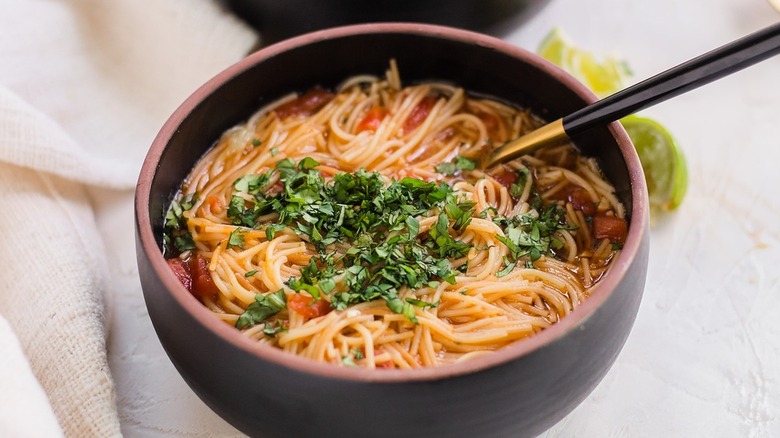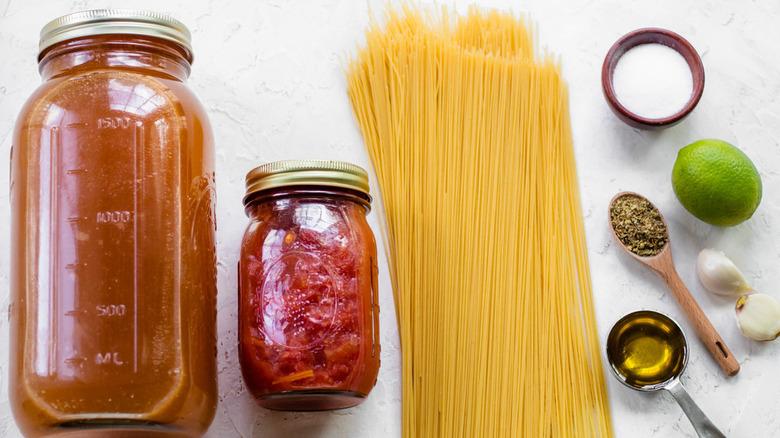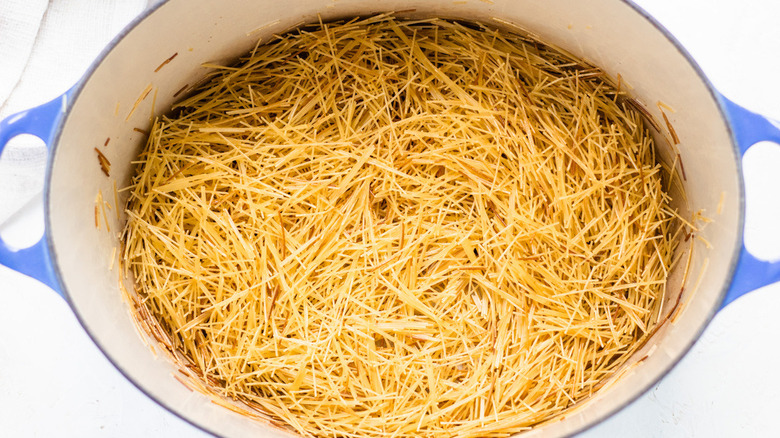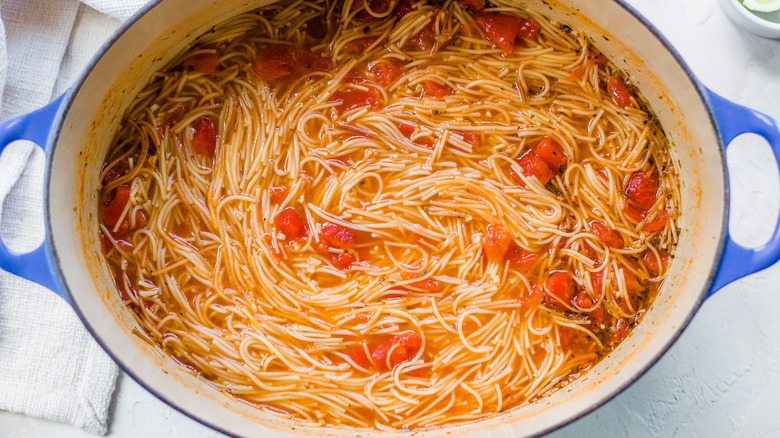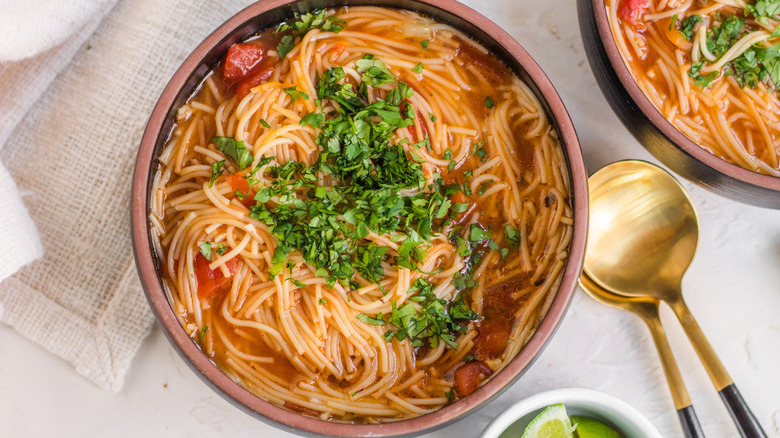Easy Fideo Recipe
We may receive a commission on purchases made from links.
If you're looking for a flavor-packed dish that works as a soup, a side, or a main course, you can't go wrong with fideo. The traditional Mexican dish has a comforting nostalgia factor, thanks to the warm broth and flavorful noodles. Recipe developer Jaime Shelbert put together this recipe, and she loves how easy it is to make for a quick dinner, noting that it's also "super customizable." She teases the many possibilities: "You can add any vegetables you have on hand and even stir in cheese and herbs of choice."
You start the recipe by toasting the noodles, which not only adds warmth to the dish, but also sets fideo apart from other pastas or soups. Whether you want to make a meal that reminds you of your childhood or you want to try out a versatile new recipe, fideo is there for you. And, considering this recipe comes together in less than 20 minutes, it's a remarkably convenient recipe to have in your back pocket, too.
Gather the ingredients for this easy fideo
Because fideo is a noodle-based dish, you'll need some pasta — specifically, angel hair pasta. "I used traditional angel hair noodles and broke them myself," Shelbert explains. "You can actually buy fideo pasta, which is basically pre-cut spaghetti." Aside from the pasta, you'll need olive oil, dried oregano, minced garlic, vegetable broth, and a can of diced tomatoes, and if you so choose, some toppings, like cilantro, lime juice, or cheese.
Shelbert does note that there's room for some ingredient additions and swaps. "You can use chicken broth and even throw in bay leaves during cooking," she notes. She also says you can use fresh, cut-up tomatoes instead of canned ones — about 2 cups worth.
Toast the angel hair pasta
To get started on this recipe, first add the olive oil to a large pot or Dutch oven over medium heat. Break the pasta down into 1- to 2-inch pieces, then add them to the pot. Saute the noodles for about 5 minutes, until they become golden brown and toasty.
Add the oregano, garlic, broth, and tomatoes to build the soup
With the pasta nice and toasted, you can continue to build the fideo. Add the oregano and garlic to the pot with the noodles and stir for about a minute, or until the garlic becomes fragrant. Pour in the broth and tomatoes and crank the heat up to high. Once you reach a boil, lower the heat and maintain a low boil, for about 4 minutes, or until the noodles are cooked and tender. Give your soup a little taste test and add salt if needed.
Garnish with cilantro, lime, or cheese, and serve your fideo
Your easy fideo is now ready for serving! Simply ladle the soup into bowls, and optionally add Shelbert's recommended toppings of cilantro, lime, or cheese. "You can serve this with a quesadilla or grilled cheese," Shelbert suggests, adding that you could also pair it with tortilla chips and guacamole. If you happen to have leftovers, you're in luck — Shelbert says you can store them in an airtight container for up to 5 days (though you may want to store the cooked pasta separately from the broth to avoid super-mushy noodles). That means that you can easily reheat and enjoy this easy fideo all week long!
What can I serve with fideo?
Easy Fideo Recipe
Learn how to make this comforting Mexican soup, made with tomatoes and pasta. The secret? Toasting your noodles before cooking them directly in the broth!
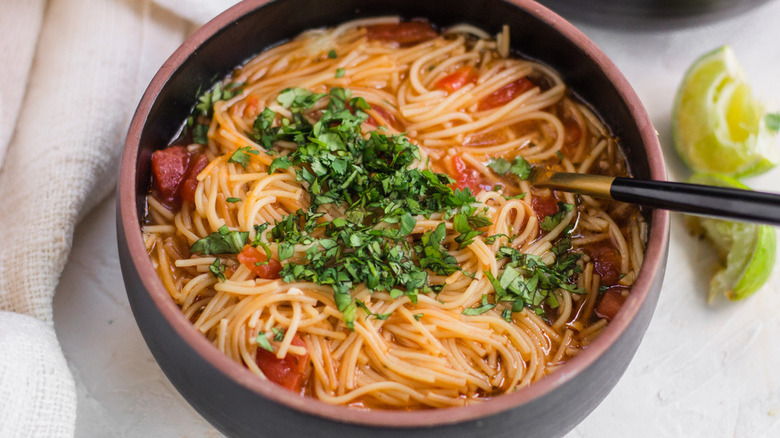
Ingredients
- 1 tablespoon extra virgin olive oil
- ½ pound angel hair pasta
- 1 teaspoon dried oregano
- 2 large garlic cloves, minced
- 8 cups vegetable broth
- 1 (14-ounce) can diced tomatoes
- salt, to taste
Optional Ingredients
- Cilantro, for serving
- Lime wedges, for serving
- Cheese, for serving
Directions
- Heat the olive oil in a large stockpot or Dutch oven over medium heat.
- Break the pasta into 1- to 2-inch pieces and add them to the pot. Sauté the noodles until toasted and golden brown, about 4 to 5 minutes.
- Add the oregano and garlic to the noodles and stir until fragrant, about 1 minute more.
- Add the broth and tomatoes, increase the heat to high, and bring to a boil. Once boiling, lower the heat to a low boil for 4 minutes, or until the noodles are cooked.
- Add salt to taste.
- Ladle the fideo into bowls and add desired toppings.
Nutrition
| Calories per Serving | 177 |
| Total Fat | 3.1 g |
| Saturated Fat | 0.5 g |
| Trans Fat | 0.0 g |
| Cholesterol | 0.0 mg |
| Total Carbohydrates | 31.6 g |
| Dietary Fiber | 2.7 g |
| Total Sugars | 2.9 g |
| Sodium | 955.1 mg |
| Protein | 5.7 g |
What are some versions of fideo from around the world?
Sopa de fideo means "noodle soup," and the recipe is likely centuries old and probably spread around the world from one country to another through trade and colonization routes. Wherever you find it, the dish usually involves pasta that is dry-toasted and then cooked in some sort of broth. As the name implies, the dish is believed to have originated in Spain, though some food historians have noted Islamic or Jewish routes that stretch even further back — to the very early days of spaghetti.
To this day, variations on the dish are usually tied to the travels of Spanish merchants or traders over the centuries. In Spain, the dish is made with thin wheat-based noodles and simmered in fish or chicken broth and often includes additions like peppers, onion, and garlic, making it very similar to the Mexican version that we present here. In the Philippines, sopa de fideo calls for glass noodles and might feature a wider variety of additional ingredients, including milk, corn, and meat. The simplest version might be from Greece and is called fide. This staple of Greek cuisine contains no broth, only thin dried noodles, water, olive oil, and sometimes a bit of mizithra cheese on top. It is a soup meant to comfort, and is often prepared for children or people who are feeling under the weather.
